light MERCEDES-BENZ EQC SUV 2021 Owners Manual
[x] Cancel search | Manufacturer: MERCEDES-BENZ, Model Year: 2021, Model line: EQC SUV, Model: MERCEDES-BENZ EQC SUV 2021Pages: 453, PDF Size: 8.68 MB
Page 5 of 453
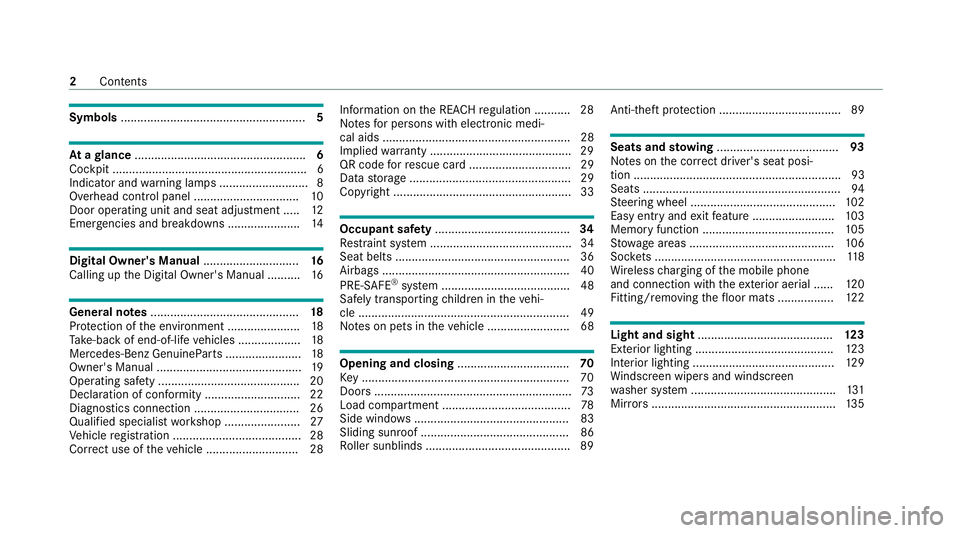
Symbols
........................................................ 5At
agl ance .................................................... 6
Cockpit ........................................................... 6
Indica tor and warning lamps .......................... .8
Overhead contro l panel ................................ 10
Door operating unit and seat adjustment ..... 12
Emergencies and breakdowns ...................... 14Digital Owner's Manual
.............................16
Calling up the Digital Owner's Manual ..........16 Genera
l notes............................................. 18
Pr otection of the environment ......................18
Ta ke -ba ckof end-of-life vehicles ...................18
Mercedes-Benz GenuineParts ....................... 18
Owner's Manual ............................................ 19
Operating saf ety .......................................... .20
Declaration of conformity ............................. 22
Diagno stics connection ................................ 26
Qualified specialist workshop ....................... 27
Ve hicle registration ....................................... 28
Cor rect use of theve hicle ............................28 Information on
the REA CHregulation ........... 28
No tesfo r persons with electronic medi‐
cal aids ......................................................... 28
Implied warranty .......................................... .29
QR code forre scue card ...............................29
Data storage .................................................29
Copyright ...................................................... 33 Occupant saf
ety......................................... 34
Re stra int sy stem ...........................................34
Seat belts ..................................................... 36
Airbags ......................................................... 40
PRE-SAFE ®
sy stem ....................................... 48
Safely transporting children in theve hi‐
cle ................................................................49
No tes on pets in theve hicle .........................68 Opening and closing
.................................. 70
Ke y .............................................................. .70
Doo rs............................................................ 73
Load compartment ....................................... 78
Side windo ws............................................... 83
Sliding sunroof ............................................. 86
Ro ller sunblinds ............................................ 89 Anti-
theft pr otection .....................................89 Seats and
stowing ..................................... 93
No tes on the cor rect driver's seat posi‐
tion ............................................................... 93
Seats ............................................................ 94
St eering wheel ............................................ 102
Easy entry and exitfeature ........................ .103
Memory function ........................................ 105
St ow age areas ............................................ 106
Soc kets ....................................................... 11 8
Wi reless charging of the mobile phone
and connection with theex terior aerial ...... 12 0
Fitting/removing thefloor mats ................. 12 2 Light and sight
......................................... 12 3
Exterior lighting .......................................... 12 3
Interior lighting ........................................... 12 9
Wi ndsc reen wipers and windscreen
wa sher sy stem ............................................ 131
Mir rors ........................................................ 13 52
Contents
Page 10 of 453
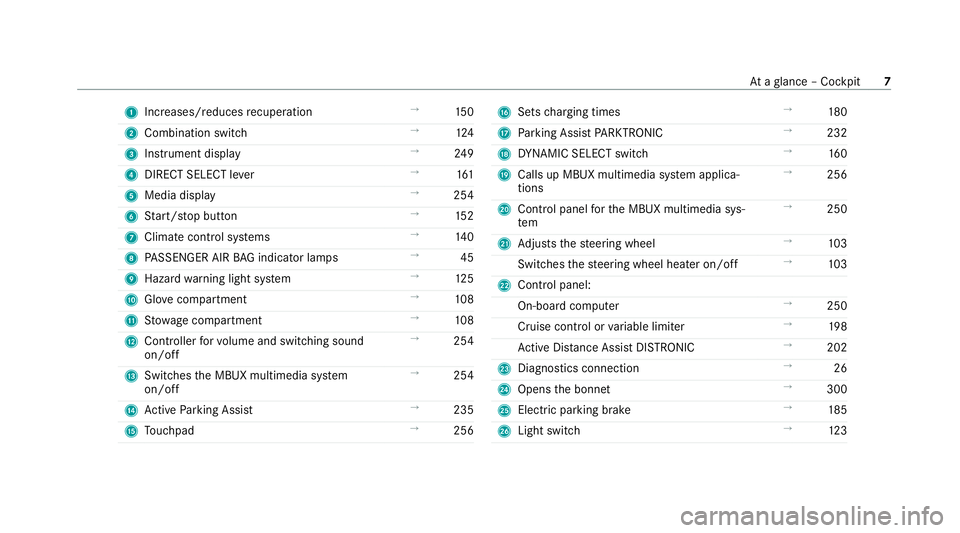
1
Increases/reduces recuperation →
15 0
2 Combination swit ch →
124
3 Instrument display →
24 9
4 DIRECT SELECT le ver →
161
5 Media display →
254
6 Start/ stop button →
15 2
7 Climate cont rol sy stems →
14 0
8 PASSENGER AIR BAG indicator lamps →
45
9 Hazard warning light sy stem →
12 5
A Glovecompa rtment →
108
B Stow age compartment →
108
C Controller forvo lume and switching sound
on/off →
254
D Swit ches the MBUX multimedia sy stem
on/off →
254
E Active Parking Assist →
235
F Touchpad →
256 G
Sets charging times →
180
H Parking Assist PARKTRONIC →
232
I DYNA MIC SELECT switch →
16 0
J Calls up MBUX multimedia sy stem applica‐
tions →
256
K Control panel forth e MBUX multimedia sys‐
tem →
250
L Adjusts thesteering wheel →
103
Switches thesteering wheel heater on/off →
103
M Control panel:
On-board co mputer →
250
Cruise cont rol or variable limiter →
19 8
Ac tive Dis tance Assi stDISTRONIC →
202
N Diagno stics connection →
26
O Opens the bonn et →
300
P Electric parking brake →
185
Q Light switch →
12 3 At
aglance – Cockpit 7
Page 12 of 453
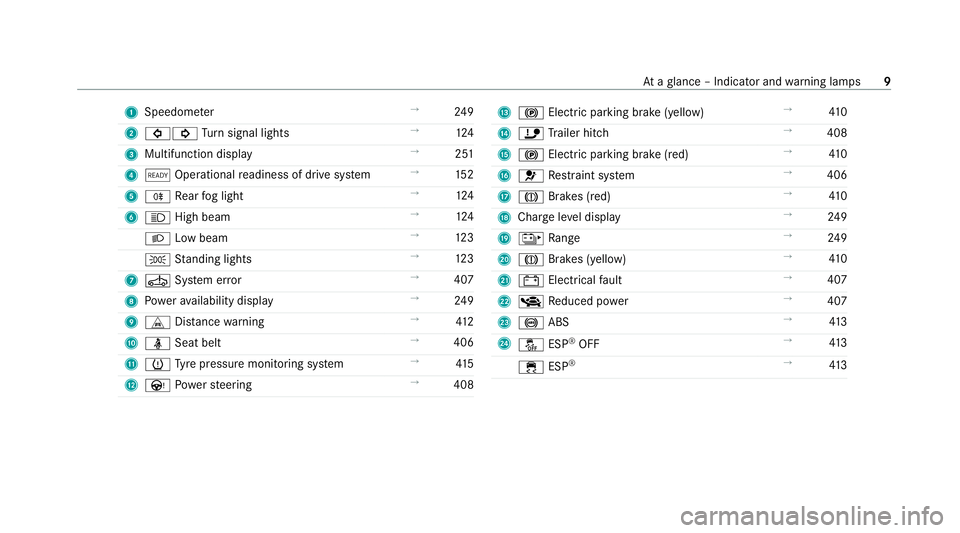
1
Speedom eter →
24 9
2 #! Turn signal lights →
124
3 Multifunction display →
251
4 õ Operational readiness of drive sy stem →
15 2
5 R Rear fog light →
124
6 K High beam →
124
L Low beam →
12 3
T Standing lights →
12 3
7 Ú System er ror →
407
8 Powe rav ailability display →
24 9
9 L Distance warning →
412
A ü Seat belt →
406
B h Tyre pressure monitoring sy stem →
41 5
C Ù Powe rst eering →
408 D
! Electric pa rking brake (yellow) →
41 0
E ï Trailer hit ch →
408
F ! Electric parking brake (red) →
41 0
G 6 Restra int sy stem →
406
H J Brakes (red) →
41 0
I Char geleve l display →
24 9
J R Range →
24 9
K J Brakes (yell ow) →
41 0
L # Electrical fault →
407
M _ Reduced po wer →
407
N ! ABS →
413
O å ESP®
OFF →
413
÷ ESP®
→
413 At
aglance – Indicator and warning lamps 9
Page 14 of 453
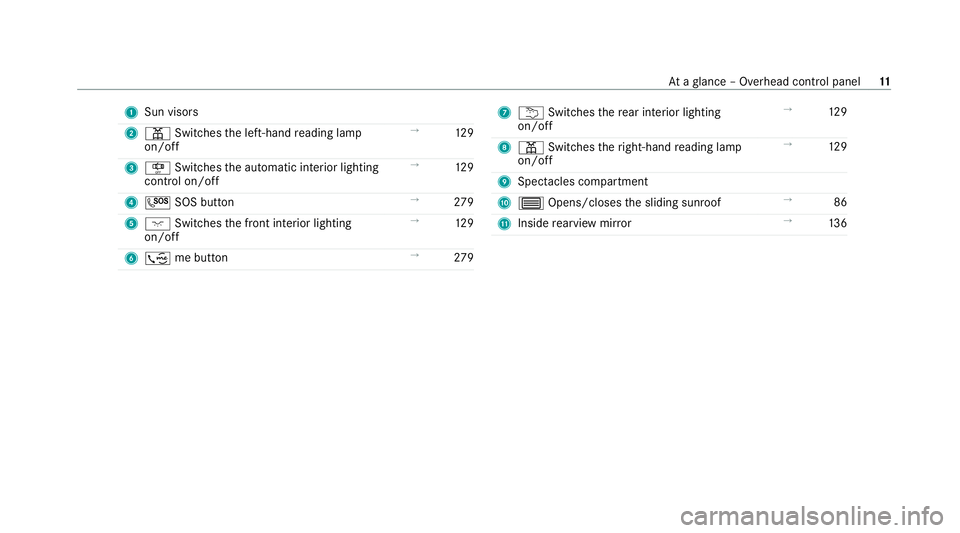
1
Sun visors
2 p Switches the left-hand reading lamp
on/off →
12 9
3 S Switches the automatic interior lighting
control on/off →
12 9
4 G SOS button →
279
5 c Switches the front interior lighting
on/off →
12 9
6 ; me button →
279 7
u Switches there ar interior lighting
on/off →
12 9
8 p Switches theright-hand reading lamp
on/off →
12 9
9 Spectacles compa rtment
A 3 Opens/closes the sliding sunroof →
86
B Inside rearview mir ror →
13 6 At
aglance – Overhead control panel 11
Page 18 of 453
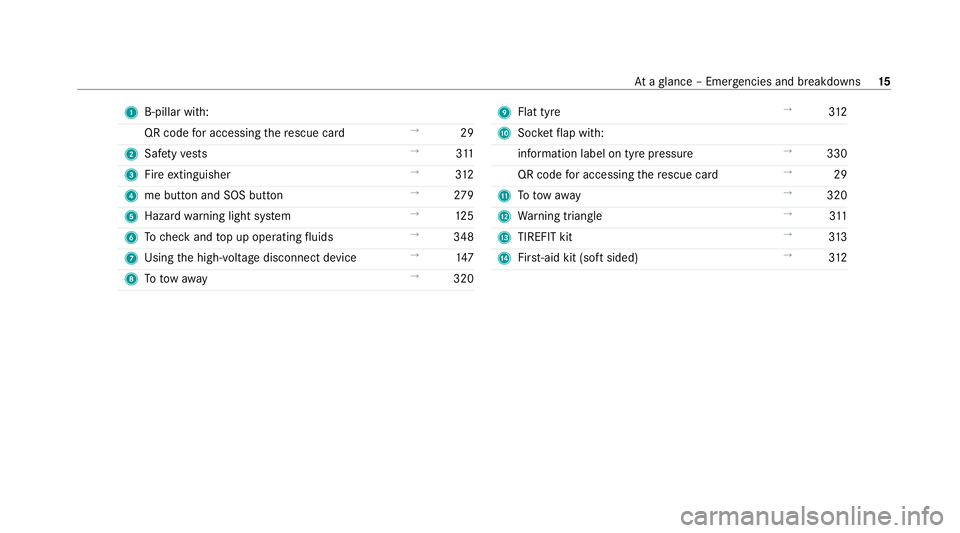
1
B-pillar wi th:
QR code for accessing there scue card →
29
2 Safetyve sts →
311
3 Fire extinguisher →
312
4 me button and SOS button →
279
5 Haza rdwa rning light sy stem →
12 5
6 Tocheck and top up operating fluids →
348
7 Using the high-voltage disconnect device →
147
8 Totow aw ay →
320 9
Flat tyre →
312
A Socketflap with:
information label on tyre pressure →
330
QR code for accessing there scue card →
29
B Totow aw ay →
320
C Warning triangle →
311
D TIREFIT kit →
313
E First-aid kit (so ftsided) →
312 At
aglance – Emer gencies and breakdowns 15
Page 33 of 453
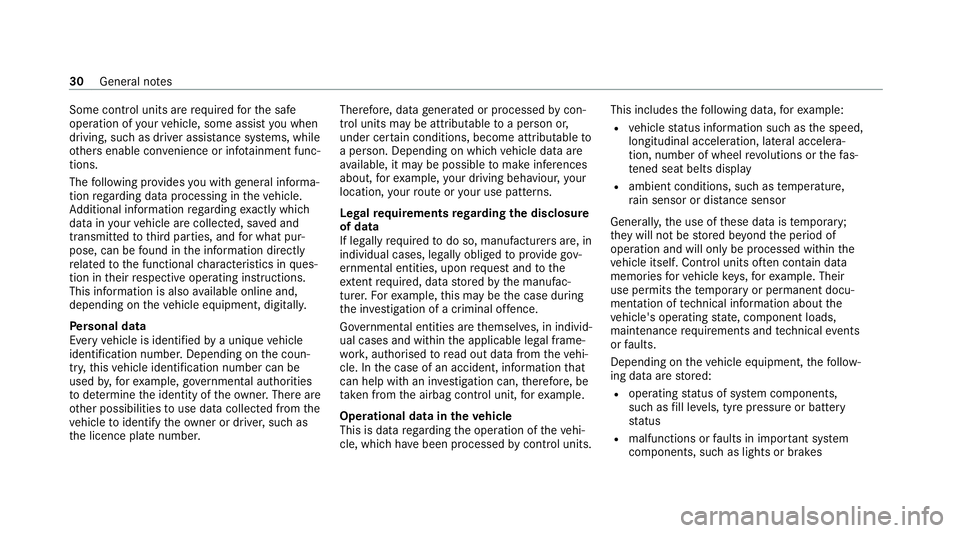
Some control units are
requ ired forth e safe
operation of your vehicle, some assist you when
driving, such as driver assis tance sy stems, while
ot hers enable con venience or inf otainment func‐
tions.
The following pr ovides you with general informa‐
tion rega rding data processing in theve hicle.
Ad ditional information rega rding exact ly which
da ta inyour vehicle are collected, sa ved and
transmit tedto third parties, and for what pur‐
pose, can be found in the information directly
re lated tothe functional characteristics in ques‐
tion in their respective operating instructions.
This information is also available online and,
depending on theve hicle equipment, digitally.
Pe rsonal data
Every vehicle is identified bya unique vehicle
identification number. Depending on the coun‐
tr y, this vehicle identification number can be
used by,fo rex ample, go vernmental auth orities
to determ ine the identity of theow ner. The reare
ot her possibilities touse data collec ted from the
ve hicle toidentify theow ner or driver, su chas
th e licence plate number. Therefore, data
generated or processed bycon‐
trol units may be attributable toa person or,
under cer tain conditions, become att ributable to
a person. Depending on which vehicle data are
av ailable, it may be possible tomake inferences
about, forex ample, your driving behaviour, your
location, your route or your use pat tern s.
Legal requirements rega rding the disclosure
of data
If legally requ ired todo so, manufacturers are, in
individual cases, legally obliged toprov ide gov‐
ernmental entities, upon request and tothe
ex tent requ ired, data stored bythe manufac‐
turer. Forex ample, this may be the case during
th e in vestigation of a criminal of fence.
Go vernmental entities are themselves, in individ‐
ual cases and within the applicable legal frame‐
wo rk, authorised toread out data from theve hi‐
cle. In the case of an accident, information that
can help with an in vestigation can, therefore, be
ta ke n from the airbag control unit, forex ample.
Operational data in theve hicle
This is data rega rding the operation of theve hi‐
cle, which ha vebeen processed bycontrol units. This includes
thefo llowing data, forex ample:
R vehicle status information such as the speed,
longitudinal acceleration, lateral accelera‐
tion, number of wheel revo lutions or thefa s‐
te ned seat belts displ ay
R ambient conditions, such as temp erature,
ra in sensor or dis tance sensor
General ly,th e use of these data is temp orar y;
th ey will not be stored be yond the period of
operation and will only be processed within the
ve hicle itself. Control units of ten contain da ta
memories forve hicle keys,fo rex ample. Their
use permits thete mp orary or permanent docu‐
mentation of tech nical information about the
ve hicle's operating state, component loads,
main tenance requ irements and tech nical events
or faults.
Depending on theve hicle equipment, thefo llow‐
ing data are stored:
R operating status of sy stem components,
such as fill le vels, tyre pressure or battery
st atus
R malfunctions or faults in impor tant sy stem
components, such as lights or brakes 30
General no tes
Page 34 of 453
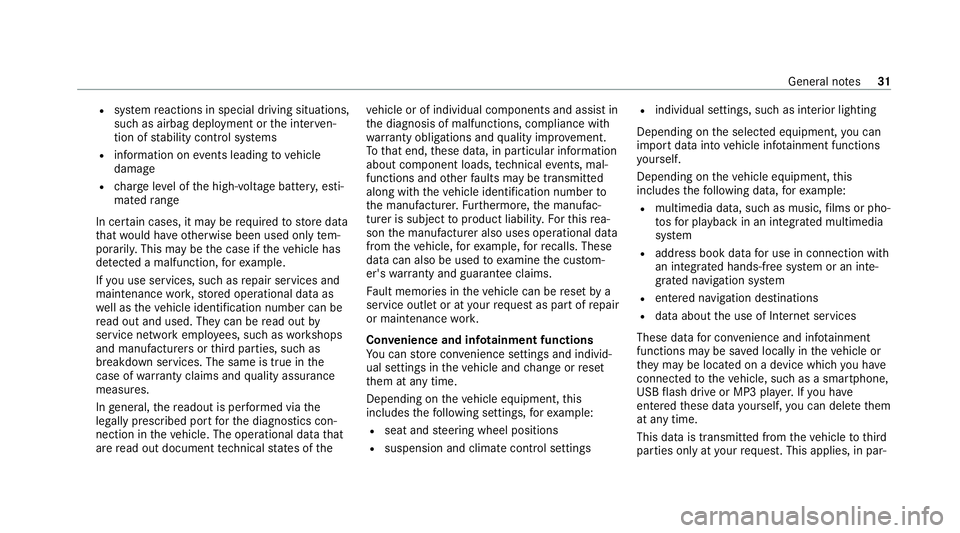
R
system reactions in special driving situations,
such as airbag deployment or the inter ven‐
tion of stability control sy stems
R information on events leading tovehicle
damage
R charge leve l of the high-voltage batter y,esti‐
mated range
In cer tain cases, it may be requiredtostore data
th at wo uld ha veotherwise been used only tem‐
poraril y.This may be the case if theve hicle has
de tected a malfunction, forex ample.
If yo u use services, such as repair services and
maintenance work,st ored operational data as
we ll as theve hicle identification number can be
re ad out and used. They can be read out by
service network emplo yees, such as workshops
and manufacturers or third parties, such as
breakdown services. The same is true in the
case of warranty claims and quality assurance
measures.
In general, there adout is per form ed via the
legally prescribed port forth e diagnostics con‐
nection in theve hicle. The operational data that
are read out document tech nical states of the ve
hicle or of individual components and assist in
th e diagnosis of malfunctions, compliance with
wa rranty obligations and quality impr ovement.
To that end, these data, in particular information
about component loads, tech nical events, mal‐
functions and other faults may be transmitted
along with theve hicle identification number to
th e manufacturer. Furthermore, the manufac‐
turer is subject toproduct liability. Forth is rea‐
son the manufacturer also uses operational data
from theve hicle, forex ample, forre calls. These
da ta can also be used toexamine the cus tom‐
er's warranty and guarantee claims.
Fa ult memories in theve hicle can be reset by a
service outlet or at your requ est as part of repair
or maintenance work.
Con venience and inf otainment functions
Yo u can store con venience settings and individ‐
ual settings in theve hicle and change or reset
th em at any time.
Depending on theve hicle equipment, this
includes thefo llowing settings, forex ample:
R seat and steering wheel positions
R suspension and climate control settings R
individual settings, such as interior lighting
Depending on the selected equipment, you can
import data into vehicle inf otainment functions
yo urself.
Depending on theve hicle equipment, this
includes thefo llowing data, forex ample:
R multimedia data, such as music, films or pho‐
to sfo r playback in an integrated multimedia
sy stem
R address book data for use in connection with
an integrated hands-free sy stem or an inte‐
grated navigation sy stem
R entered navigation destinations
R data about the use of Internet services
These data for con venience and inf otainment
functions may be sa ved locally in theve hicle or
th ey may be located on a device which you ha ve
connected totheve hicle, such as a smartphone,
USB flash drive or MP3 pla yer.If yo u ha ve
entered these data yourself, you can dele tethem
at any time.
This data is transmit ted from theve hicle tothird
parties only at your requ est. This applies, in par‐ General no
tes31
Page 38 of 453
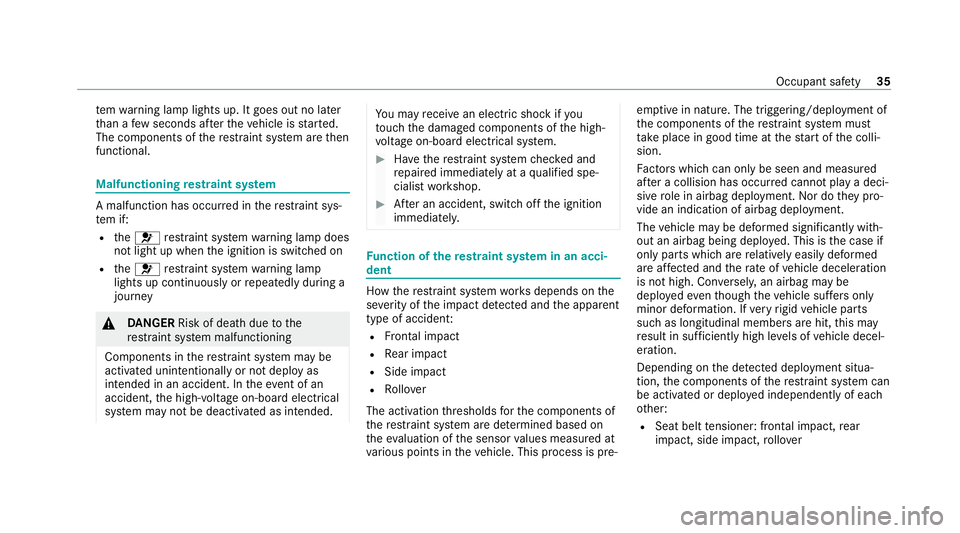
te
m wa rning lamp lights up. It goes out no later
th an a few seconds af terth eve hicle is star ted.
The components of there stra int sy stem are then
functional. Malfunctioning
restra int sy stem A malfunction has occur
red in there stra int sys‐
te m if:
R the6 restra int sy stem warning lamp does
not light up when the ignition is switched on
R the6 restra int sy stem warning lamp
lights up continuously or repeatedly during a
journey &
DANG ER Risk of death due tothe
re stra int sy stem malfunctioning
Components in there stra int sy stem may be
activated unintentionally or not deploy as
intended in an accident. In theeve nt of an
accident, the high-voltage on-board electrical
sy stem may not be deactivated as intended. Yo
u may recei vean electric shock if you
to uch the damaged components of the high-
vo ltage on-board elect rical sy stem. #
Have there stra int sy stem checked and
re paired immediately at a qualified spe‐
cialist workshop. #
After an accident, switch off the ignition
immediatel y. Fu
nction of there stra int sy stem in an acci‐
dent How
there stra int sy stem works depends on the
se verity of the impact de tected and the apparent
type of acciden t:
R Frontal impact
R Rear impact
R Side impact
R Rollover
The activation thre sholds forth e components of
th ere stra int sy stem are de term ined based on
th eev aluation of the sensor values measured at
va rious points in theve hicle. This process is pre- em
ptive in nature. The triggering/deployment of
th e components of there stra int sy stem must
ta ke place in good time at thest art of the colli‐
sion.
Fa ctors whi chcan only be seen and measu red
af te r a collision has occur red cann otplay a deci‐
sive role in airbag deployment. Nor do they pro‐
vide an indication of airbag deployment.
The vehicle may be deformed significantly with‐
out an airbag being deplo yed. This is the case if
only parts which are relatively easily deformed
are af fected and thera te ofvehicle deceleration
is not high. Con versely, an airbag may be
deplo yedev en though theve hicle suf fers only
minor deformation. If very rigid vehicle parts
such as longitudinal members are hit, this may
re sult in suf ficiently high le vels of vehicle decel‐
eration.
Depending on the de tected deployment situa‐
tion, the components of there stra int sy stem can
be activated or deplo yed independently of each
ot her:
R Seat belt tensioner: frontal impact, rear
impact, side impact, rollo ver Occupant saf
ety35
Page 49 of 453
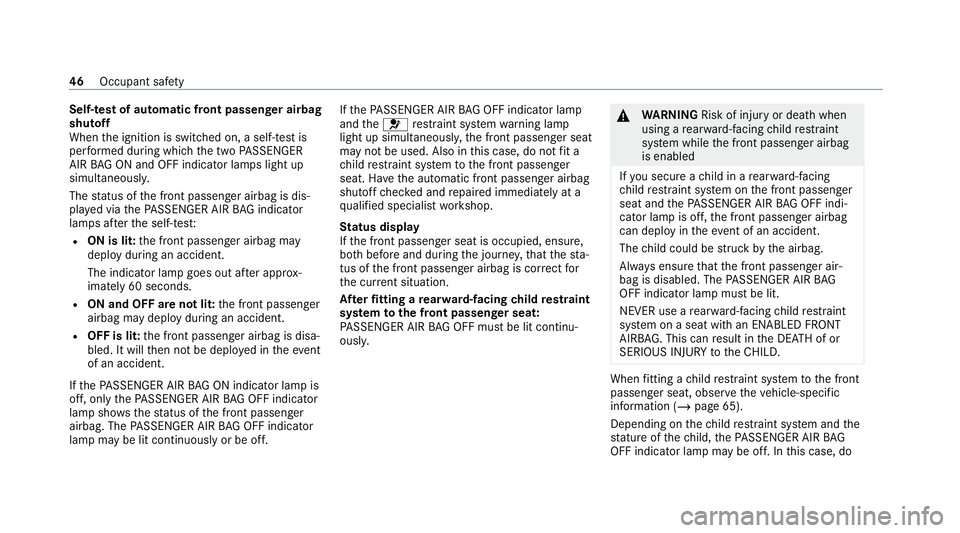
Self-test of automatic front passenger airbag
shutoff
When
the ignition is switched on, a self-test is
per form ed during which the two PASSENGER
AIR BAG ON and OFF indicator lamps light up
simul taneously.
The status of the front passenger airbag is dis‐
pla yed via thePA SSENGER AIR BAG indicator
lamps af terth e self-tes t:
R ON is lit: the front passenger airbag may
deploy during an accident.
The indicator lamp goes out af ter appro x‐
ima tely 60 seconds.
R ON and OF F are not lit: the front passenger
airbag may deploy during an accident.
R OFF is lit: the front passenger airbag is disa‐
bled. It will then not be deplo yed in theev ent
of an accident.
If th ePA SSENGER AIR BAG ON indicator lamp is
off, on lythePA SSENGER AIR BAG OFF indicator
lamp sho ws thest atus of the front passenger
airbag. The PASSENGER AIR BAG OFF indicator
lamp may be lit continuously or be off. If
th ePA SSENGER AIR BAG OFF indicator lamp
and the6 restra int sy stem warning lamp
light up simultaneousl y,the front passenger seat
may not be used. Also in this case, do not fit a
ch ild restra int sy stem tothe front passenger
seat. Ha vethe automatic front passenger airbag
shutoff checked and repaired immediately at a
qu alified specialist workshop.
St atus display
If th e front passenger seat is occupied, ensure,
bo th before and during the journe y,that thest a‐
tus of the front passenger airbag is cor rect for
th e cur rent situation.
Af terfitting a rear wa rd-facing child restra int
sy stem tothe front passenger seat:
PA SSENGER AIR BAG OFF must be lit continu‐
ousl y. &
WARNING Risk of inju ryor death when
using a rear wa rd-facing child restra int
sy stem while the front passenger airbag
is enabled
If yo u secure a child in a rear wa rd-facing
ch ild restra int sy stem on the front passenger
seat and thePA SSENGER AIR BAG OFF indi‐
cator lamp is off, the front passenger airbag
can deploy in theev ent of an accident.
The child could be stru ck bythe airbag.
Alw ays ensure that the front passenger air‐
bag is disabled. The PASSENGER AIR BAG
OFF indicator lamp must be lit.
NEVER use a rear wa rd-facing child restra int
sy stem on a seat with an ENABLED FRONT
AIRB AG. This can result in the DEAT H of or
SERIOUS INJU RYtotheCH ILD. When
fitting a child restra int sy stem tothe front
passenger seat, obser vetheve hicle-specific
information (/ page 65).
Depending on thech ild restra int sy stem and the
st ature of thech ild, thePA SSENGER AIR BAG
OFF indicator lamp may be off. In this case, do 46
Occupant saf ety
Page 52 of 453
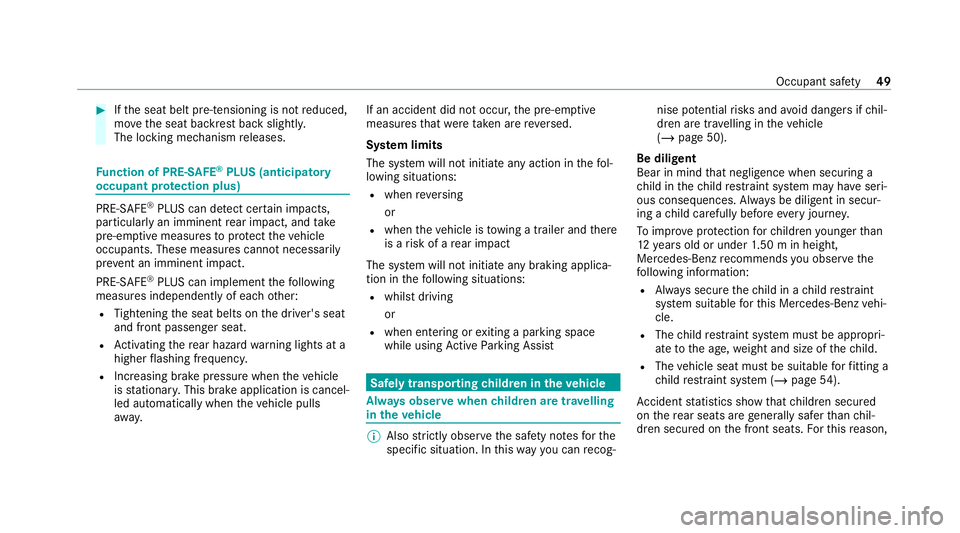
#
Ifth e seat belt pre-tensioning is not reduced,
mo vethe seat backrest back slightl y.
The locking mechanism releases. Fu
nction of PRE-SAFE ®
PLUS (anticipatory
occupant pr otection plus) PRE-
SAFE®
PLUS can de tect cer tain impacts,
particular lyan imminent rear impact, and take
pre-em ptive measures toprotect theve hicle
occupants. These measures cannot necessarily
pr eve nt an imminent impact.
PRE-SAFE ®
PLUS can implement thefo llowing
measures independently of each other:
R Tightening the seat belts on the driver's seat
and front passenger seat.
R Activating there ar hazard warning lights at a
higher flashing frequenc y.
R Increasing brake pressure when theve hicle
is stationar y.This brake application is cancel‐
led automatically when theve hicle pulls
aw ay. If an accident did not occur,
the pre-em ptive
measures that we retake n are reve rsed.
Sy stem limits
The sy stem will not initiate any action in thefo l‐
lowing situations:
R when reve rsing
or
R when theve hicle is towing a trailer and there
is a risk of a rear impact
The sy stem will not initiate any braking applica‐
tion in thefo llowing situations:
R whilst driving
or
R when entering or exiting a parking space
while using Active Parking Assist Safely transporting
children in theve hicle Alw
ays obser vewhen children are tr avelling
in theve hicle %
Also strictly obser vethe saf ety no tesfo rthe
specific situation. In this wa yyo u can recog‐ nise po
tential risks and avoid dangers if chil‐
dren are tr avelling in theve hicle
(/ page 50).
Be diligent
Bear in mind that negligence when securing a
ch ild in thech ild restra int sy stem may ha veseri‐
ous consequences. Alw ays be diligent in secur‐
ing a child carefully before everyjou rney.
To impr oveprotection forch ildren younger than
12 years old or under 1.50 m in height,
Mercedes-Benz recommends you obse rvethe
fo llowing information:
R Alw ays secure thech ild in a child restra int
sy stem suitable forth is Mercedes-Benz vehi‐
cle.
R The child restra int sy stem must be appropri‐
ate tothe age, weight and size of thech ild.
R The vehicle seat must be suitable forfitting a
ch ild restra int sy stem (/ page54).
Ac cident statistics show that children secured
on there ar seats are general lysafer than chil‐
dren secured on the front seats. Forth is reason, Occupant saf
ety49